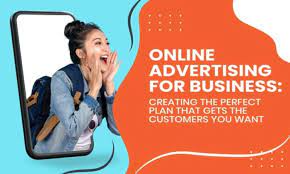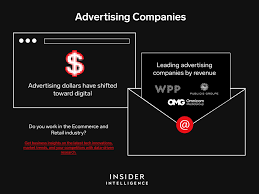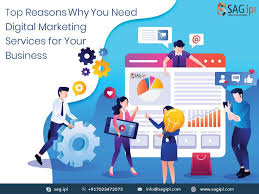Online Ads: The Power of Digital Advertising
In today’s interconnected world, online advertising has become an essential tool for businesses to reach their target audience and promote their products or services. With the rise of the internet and the increasing number of people spending significant amounts of time online, online ads have proven to be a highly effective and efficient way to connect with potential customers.
One of the biggest advantages of online ads is their ability to reach a vast audience. Unlike traditional forms of advertising, such as print or television, online ads can be targeted to specific demographics, interests, and locations. This level of precision allows businesses to maximize their marketing budgets by focusing on those who are most likely to be interested in what they have to offer.
Another key benefit of online ads is their flexibility. Businesses have a wide range of options when it comes to choosing the format and placement of their ads. From display banners on popular websites, sponsored posts on social media platforms, to video ads on streaming services, there are numerous ways to capture the attention of potential customers. This versatility allows businesses to tailor their ad campaigns based on their specific goals and target audience.
Furthermore, online ads provide valuable data and insights that can help businesses refine their marketing strategies. With advanced analytics tools, businesses can track metrics such as click-through rates, conversions, and customer engagement. This data allows them to measure the effectiveness of their campaigns in real-time and make necessary adjustments for better results. Such data-driven decision-making helps businesses optimize their advertising efforts and achieve higher returns on investment.
Additionally, online ads offer a level of interactivity that traditional forms of advertising cannot match. Through interactive elements such as quizzes, surveys, or gamified experiences within an ad, businesses can actively engage with potential customers and create memorable brand experiences. This interactivity not only captures attention but also encourages users to interact with the ad content and increases the likelihood of conversion.
However, it’s important for businesses to approach online advertising strategically. With the abundance of ads online, it’s crucial to create compelling and relevant content that stands out from the competition. Ad fatigue is a real concern, and businesses must find innovative ways to capture and retain the attention of their target audience.
In conclusion, online ads have revolutionized the advertising landscape by providing businesses with unprecedented reach, flexibility, and data-driven insights. They offer an efficient and cost-effective way to connect with potential customers and drive business growth. By leveraging the power of digital advertising, businesses can stay ahead in today’s competitive market and effectively promote their products or services to a global audience.
Common Queries on Online Ads: A Comprehensive Guide for UK Businesses
- How effective are online ads in reaching and engaging target audiences?
- What are the different types of online ads available and which one is best for my business?
- How do I measure the success of my online ad campaigns?
- Can I target specific demographics or locations with online ads?
- What is the cost of running online ads, and how can I optimize my budget for maximum results?
How effective are online ads in reaching and engaging target audiences?
Online ads have proven to be highly effective in reaching and engaging target audiences. Here are a few reasons why:
- Targeting Capabilities: Online ads allow businesses to target specific demographics, interests, and locations. This level of precision ensures that ads are shown to the right people who are most likely to be interested in the product or service being advertised. By reaching a relevant audience, businesses can increase the chances of engagement and conversion.
- Wide Reach: The internet has a global reach, allowing businesses to extend their reach beyond geographical boundaries. With online ads, businesses can connect with potential customers across different platforms and websites, ensuring their message reaches a broader audience.
- Interactivity: Online ads offer various interactive elements that encourage engagement from users. Whether it’s through quizzes, polls, or interactive videos, these features capture attention and make the ad experience more enjoyable for users. Increased interactivity leads to higher engagement rates and better chances of conversion.
- Data-Driven Optimization: Online ads provide valuable data and insights that help businesses optimize their campaigns for better results. Through analytics tools, businesses can track key metrics such as click-through rates, conversions, and customer behavior. This data allows them to make data-driven decisions and refine their targeting strategies for maximum effectiveness.
- Personalization: Online ads can be tailored to individual users based on their browsing history or previous interactions with a brand. This personalization creates a more personalized ad experience and increases the likelihood of engagement from users who feel that the ad is relevant to their needs or interests.
- Cost-Effectiveness: Compared to traditional forms of advertising like print or television, online ads often offer more cost-effective options for businesses with varying budgets. Businesses have control over their ad spend and can choose from different pricing models such as pay-per-click (PPC) or cost-per-impression (CPM), ensuring they get value for their money.
Overall, online ads have proven to be highly effective in reaching and engaging target audiences. With their precise targeting capabilities, interactivity, personalization, and data-driven optimization, businesses can connect with the right people at the right time, increasing the chances of driving conversions and achieving their marketing goals.
What are the different types of online ads available and which one is best for my business?
When it comes to online advertising, there are several types of ads available, each with its own strengths and suitability for different business objectives. Here are some common types of online ads:
- Display Ads: These are visual ads that appear on websites, typically in the form of banners or images. Display ads can be static or animated and can be placed strategically on websites that align with your target audience’s interests.
- Search Engine Ads: These ads appear on search engine results pages (SERPs) when users search for specific keywords related to your business. Search engine ads allow you to target users actively looking for products or services similar to what you offer.
- Social Media Ads: Social media platforms such as Facebook, Instagram, Twitter, LinkedIn, and Pinterest offer various ad formats to reach their vast user bases. These ads can be highly targeted based on demographics, interests, and behaviors of users on these platforms.
- Video Ads: Video ads are short video clips that play before, during, or after online video content. They can be displayed on platforms like YouTube or embedded within websites and social media feeds. Video ads are effective in capturing attention and conveying messages visually.
- Native Ads: Native ads blend seamlessly with the content of a website or platform, making them appear more organic and less intrusive. They match the design and format of the surrounding content while promoting a product or service.
- Email Marketing Ads: These involve placing advertisements within email newsletters sent to subscribers who have opted in to receive promotional content from your business. Email marketing ads allow for direct communication with engaged audiences.
Choosing the best type of online ad for your business depends on various factors such as your target audience, goals, budget, and industry. It’s essential to consider your specific objectives when selecting an ad type:
– If you want to increase brand awareness or promote a new product/service visually, display ads or video ads may be suitable.
– For businesses looking to drive immediate conversions or leads, search engine ads can be effective.
– Social media ads are ideal for businesses aiming to engage with a specific audience and build brand loyalty.
– Native ads work well when you want your ads to blend seamlessly with the content of a particular platform or website.
– Email marketing ads are useful for reaching subscribers who have already shown interest in your business.
To determine the best ad type for your business, consider consulting with digital marketing professionals who can analyze your specific needs and help you develop a tailored advertising strategy.
How do I measure the success of my online ad campaigns?
Measuring the success of your online ad campaigns is crucial to understanding their effectiveness and making informed decisions for future marketing strategies. Here are some key metrics and methods you can use to measure the success of your online ad campaigns:
- Impressions: Impressions indicate the number of times your ad was displayed on a webpage. It gives you an idea of the reach and visibility of your campaign.
- Click-through Rate (CTR): CTR measures the percentage of people who clicked on your ad after seeing it. It helps assess how compelling and engaging your ad is to your target audience.
- Conversion Rate: Conversion rate measures the percentage of users who completed a desired action, such as making a purchase, filling out a form, or subscribing to a newsletter. It directly reflects the effectiveness of your ad in driving desired user actions.
- Cost per Acquisition (CPA): CPA calculates the average cost incurred to acquire one customer or lead through your ad campaign. It helps evaluate the efficiency and profitability of your campaigns.
- Return on Ad Spend (ROAS): ROAS measures the revenue generated for every dollar spent on advertising. It provides insights into the financial performance and profitability of your campaigns.
- Engagement Metrics: Depending on the type of online ads you run, engagement metrics such as likes, shares, comments, or video views can be valuable indicators of user interest and interaction with your ads.
- Website Analytics: Analyzing website traffic data using tools like Google Analytics allows you to track metrics such as bounce rate, time spent on site, pages visited, and conversion funnels. These metrics help understand how users interact with your website after clicking on an ad.
- A/B Testing: Conducting A/B tests by creating variations of ads with different elements (e.g., headlines, images, call-to-action) helps identify which version performs better in terms of click-throughs or conversions.
- Customer Surveys and Feedback: Collecting feedback from customers or conducting surveys can provide qualitative insights into their perception of your ad campaigns and their impact on their decision-making process.
- Return on Investment (ROI): Calculating the overall return on investment by comparing the revenue generated against the total cost of your ad campaigns helps determine the profitability and effectiveness of your advertising efforts.
It’s important to define clear campaign objectives, set benchmarks, and regularly monitor these metrics throughout your campaign. By analyzing these data points, you can make data-driven decisions, optimize underperforming campaigns, and allocate resources effectively for future online ad campaigns.
Can I target specific demographics or locations with online ads?
Absolutely! One of the significant advantages of online advertising is the ability to target specific demographics and locations. Online platforms, such as social media networks and search engines, offer robust targeting options that allow businesses to reach their desired audience with precision.
Demographic targeting enables you to focus your ads on specific characteristics of your target market, such as age, gender, income level, education, interests, and more. For example, if you’re selling beauty products targeted towards young women, you can set your ads to appear specifically to females aged 18-30 who have shown an interest in cosmetics or related topics.
Location targeting allows you to narrow down your audience based on geographical location. This can be as broad as targeting an entire country or as specific as targeting a particular city or even a radius around a specific location. Location targeting is particularly useful for businesses with physical storefronts or those looking to reach customers in specific regions.
By combining demographic and location targeting options, businesses can create highly tailored campaigns that ensure their ads are seen by the right people in the right places. This level of precision not only increases the effectiveness of the ads but also helps optimize marketing budgets by focusing resources on the most relevant audience segments.
It’s worth noting that different online advertising platforms may offer varying degrees of targeting capabilities. Therefore, it’s essential to explore and understand the targeting options available on each platform you choose to advertise on. This will allow you to fine-tune your campaigns and maximize their impact by reaching the most relevant audience for your business.
Overall, online advertising provides businesses with powerful tools for reaching specific demographics and locations. By leveraging these capabilities effectively, businesses can improve their ad performance and increase their chances of connecting with potential customers who are most likely to engage with their products or services.
What is the cost of running online ads, and how can I optimize my budget for maximum results?
The cost of running online ads can vary depending on several factors, including the platform you choose, the targeting options, the ad format, and the competition within your industry. Here are some key considerations to help you optimize your budget for maximum results:
- Set clear goals: Before starting any online advertising campaign, define your objectives. Whether it’s increasing brand awareness, driving website traffic, or generating leads, having clear goals will help you allocate your budget effectively.
- Choose the right platform: Different platforms offer varying costs and reach. Research and identify which platforms align with your target audience and business objectives. Some popular options include Google Ads, Facebook Ads, Instagram Ads, LinkedIn Ads, and Twitter Ads.
- Targeting options: Take advantage of targeting options provided by the advertising platforms to reach your desired audience more effectively. Narrow down your target audience based on demographics such as age, location, interests, and behavior. By focusing on a specific audience segment, you can optimize your budget by avoiding wasted impressions on irrelevant users.
- Test and optimize: Start with a small budget and test different ad variations to see what resonates best with your target audience. Monitor the performance metrics closely and make data-driven decisions to optimize your ads for better results over time.
- Ad formats: Experiment with different ad formats such as text ads, display banners, video ads, or interactive ads to see which ones yield better engagement and conversions within your budget constraints.
- Ad scheduling: Analyze when your target audience is most active online and schedule your ads accordingly. This ensures that you are maximizing visibility during peak times while minimizing costs during less active periods.
- Keyword research: If you are using search engine advertising (e.g., Google Ads), conduct thorough keyword research to identify relevant keywords that have a balance between search volume and competition level. This will help you optimize bids for maximum visibility without overspending.
- Landing page optimization: Ensure that your landing page is optimized for conversions. A well-designed, user-friendly, and persuasive landing page can significantly improve your ad’s effectiveness and maximize the return on your advertising investment.
- Monitor and adjust: Regularly monitor the performance of your ads and make necessary adjustments based on the data you collect. This includes adjusting bids, refining targeting options, or modifying ad creative to optimize your budget allocation.
Remember, online advertising is an ongoing process that requires continuous monitoring and optimization. By setting clear goals, targeting effectively, testing different strategies, and analyzing data, you can optimize your budget to achieve maximum results from your online ad campaigns.




